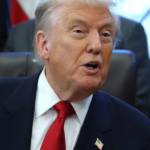“God bless America, and we’re going to save the taxpayers $56 million,” U.S. Treasurer Brandon Beach said just before hitting a button to strike the final penny.
Pennies remain legal tender, but new ones will no longer be made.
The last coin to be discontinued was the half-cent in 1857, Beach said.
President Donald Trump ordered the penny’s demise as costs climbed to nearly 4 cents per penny and the 1-cent valuation became somewhat obsolete. Billions of pennies remain in circulation, but they are rarely essential for financial transactions in the 21st century economy.
“For far too long the United States has minted pennies which literally cost us more than 2 cents,” Trump wrote in an online post in February. “This is so wasteful!”
Some rounded prices down to avoid shortchanging shoppers. Others pleaded with customers to bring exact change. The more creative among them gave out prizes, such as a free drink, in exchange for a pile of pennies.
“We have been advocating abolition of the penny for 30 years. But this is not the way we wanted it to go,” Jeff Lenard of the National Association of Convenience Stores said last month.
Some banks, meanwhile, began rationing supplies, a somewhat paradoxical result of the effort to address what many see as a glut of the coins. Over the last century, about half of the coins made at mints in Philadelphia and Denver have been pennies.
Back in 1793, a penny could get you a biscuit, a candle or a piece of candy. These days, many sit in drawers or glass jars and are basically cast aside or collected.
No matter their face value, collectors and historians consider them an important historical record that can be traced back for more than 200 years. Frank Holt, an emeritus professor at the University of Houston who has studied the history of coins, laments the loss.
“We put mottos on them and self-identifiers, and we decide — in the case of the United States — which dead persons are most important to us and should be commemorated,” he said. “They reflect our politics, our religion, our art, our sense of ourselves, our ideals, our aspirations.”








